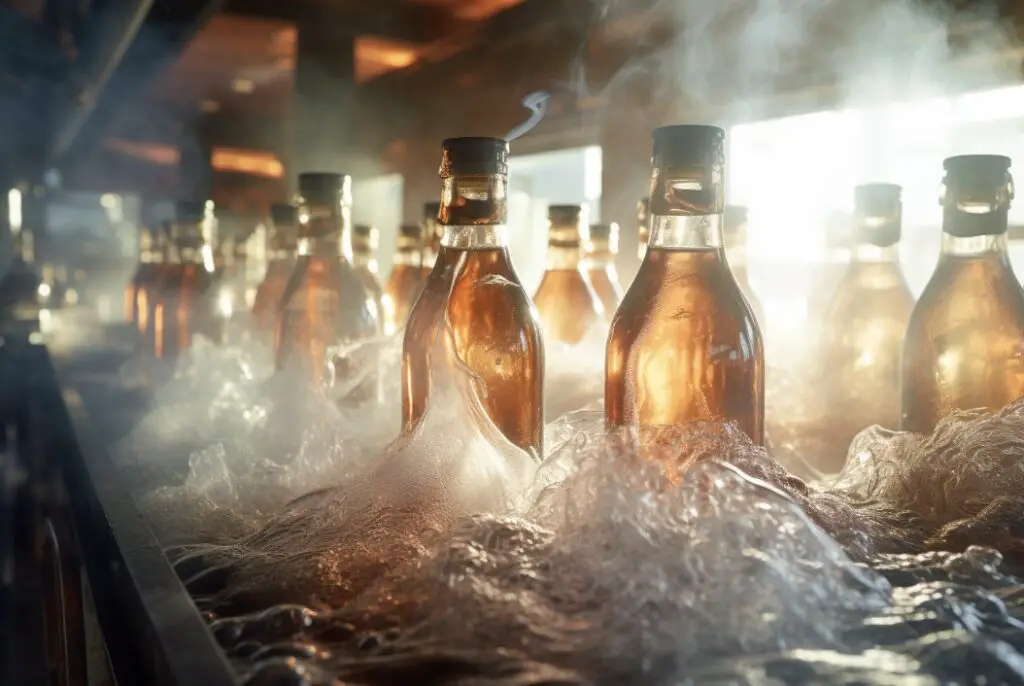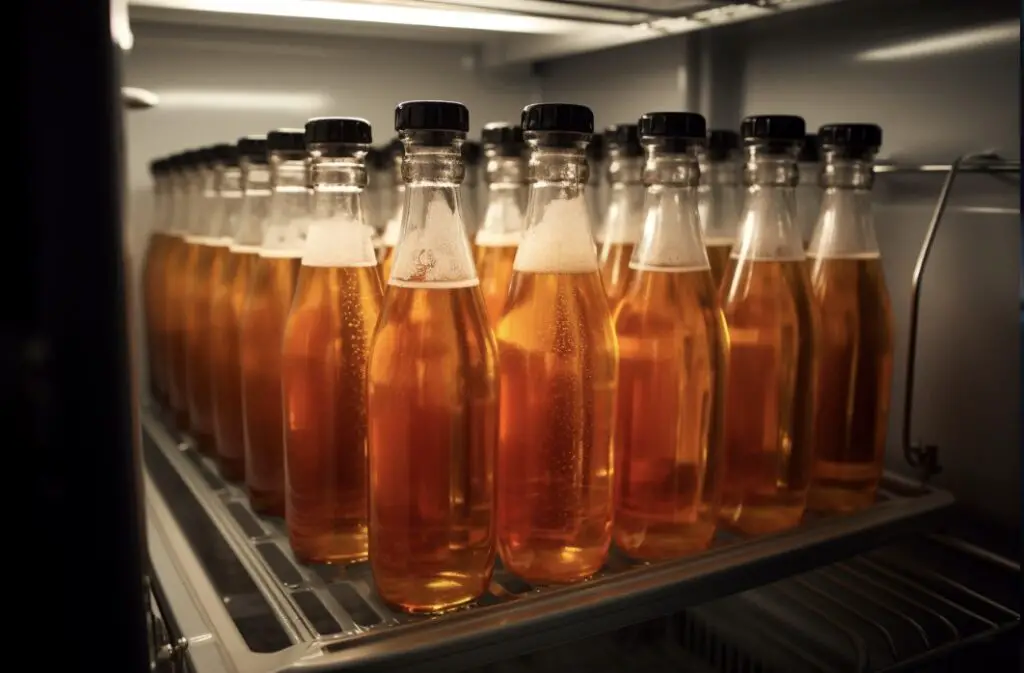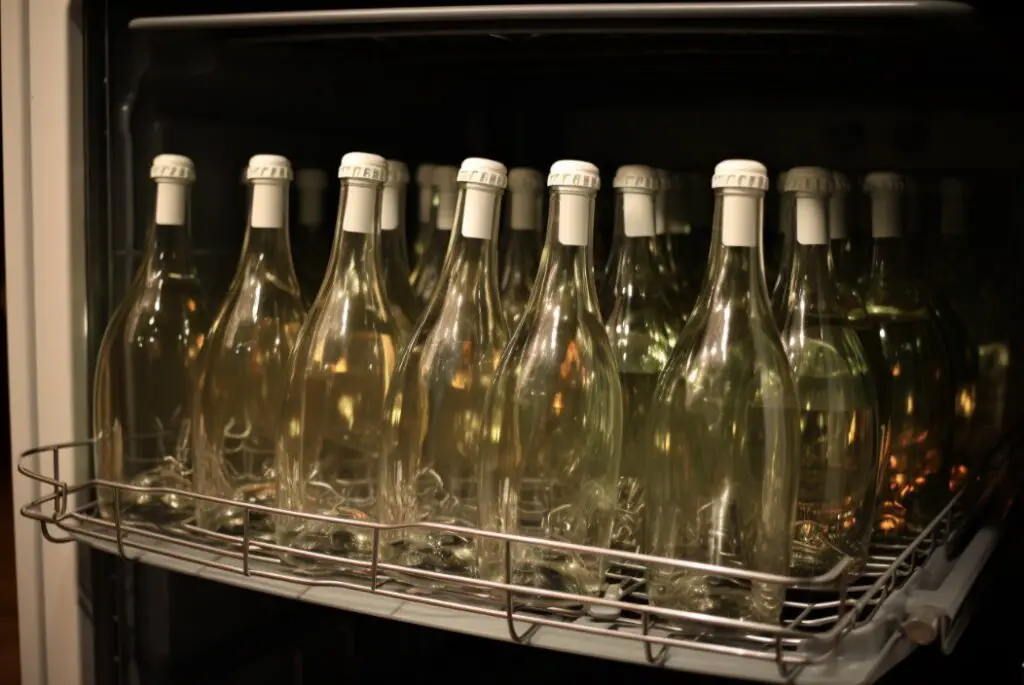Can you pasteurize wine? The answer is yes, you can pasteurize wine, and there are a few reasons why you might want to do so. In this blog post, we’ll dive deep into the world of wine pasteurization, discussing why, when, and how to pasteurize your homemade wine.
As an experienced brewer, I’ve had my fair share of successes and failures in my wine-making journey, and I’m here to share my knowledge with you.
What is Pasteurization and Why Does it Matter in Wine Making?
The Basics of Pasteurization
Pasteurization is a process invented by French scientist Louis Pasteur in the 19th century. It involves heating a liquid to a specific temperature for a certain period of time, then cooling it rapidly.
This process kills off harmful bacteria and other microorganisms, making the liquid safer to consume and extending its shelf life.

Why Pasteurize Wine?
The main reason to pasteurize wine is to ensure its stability and prevent spoilage. Wine is a delicate product that can easily be ruined by unwanted bacteria or yeast. Pasteurizing the wine helps to eliminate these unwanted organisms, ensuring that your wine remains fresh and enjoyable for longer.
When to Pasteurize Wine
Before Bottling
Pasteurizing wine before bottling is the most common method, as this ensures that your wine will be stable and free from any harmful bacteria before it is sealed in the bottle. This is especially important for wines with higher residual sugar levels, as the sugar can provide a breeding ground for unwanted microorganisms.
After Bottling
In some cases, you may choose to pasteurize your wine after bottling. This is known as bottle pasteurization, and it involves submerging the sealed bottles in heated water for a specified amount of time. This method is less common but can be useful for wines that are difficult to stabilize through other methods.
How to Pasteurize Wine
Stovetop Pasteurization
One way to pasteurize your wine is by using a stovetop pasteurizer. This involves heating the wine in a large pot, monitoring the temperature carefully to ensure that it remains at the desired level for the required amount of time. It’s important to stir the wine frequently during this process to ensure even heating. Once the wine has been pasteurized, it should be cooled rapidly to prevent any unwanted organisms from growing.
Oven Pasteurization
Sometimes boiling water can be a bit much to handle and does not service as many wine bottles at once as could fit in an oven.
The downside of oven pasteurization is that it takes significantly longer due to the poor heat conduction between air and (glass) wine compared to the water.
Here’s a step-by-step guide on how to pasteurize homemade wine using an oven:

Materials You’ll Need:
- Homemade wine that you want to pasteurize
- Oven-safe glass bottles or jars with lids
- Oven thermometer
- Baking tray
- Timer
- Pot or kettle for hot water
- Pot holders or oven gloves
- Clean cloth or towel
Steps:
- Preparation:
- Cleanliness is essential. Ensure that all equipment, bottles, and jars you’ll be using are thoroughly cleaned and sanitized to prevent contamination.
- Make sure your homemade wine is properly fermented and clarified before pasteurization.
- Bottling:
- Fill your clean glass bottles or jars with the homemade wine, leaving a bit of space at the top to allow for expansion during pasteurization. Seal the bottles with the lids but not too tightly.
- Preheat the Oven:
- Preheat your oven to the desired pasteurization temperature. The recommended temperature for pasteurizing wine is around 145°F to 160°F (62°C to 71°C). An oven thermometer placed inside the oven will help you monitor the temperature accurately.
- Placing Bottles in the Oven:
- Place the filled bottles or jars on a baking tray and position them in the preheated oven. Make sure there’s enough space between the bottles for air circulation.
- Pasteurization:
- Keep a close eye on the oven thermometer to ensure the temperature remains within the recommended range. The wine needs to be held at this temperature for a specific duration to effectively kill off any unwanted microorganisms.
- Pasteurize the wine for about 10 to 15 minutes at the desired temperature. This duration should be enough to achieve pasteurization without damaging the wine’s flavor.
- Cooling Down:
- Once the pasteurization time is up, carefully remove the baking tray from the oven using pot holders or oven gloves. Place it on a heat-resistant surface.
- Allow the bottles to cool naturally at room temperature. Do not speed up the cooling process by placing the bottles in cold water, as this could shock and possibly break them.
- Storage:
- After the bottles have cooled down, check the lids to ensure they’re properly sealed. Store the pasteurized homemade wine in a cool, dark place away from direct sunlight and temperature fluctuations.
- Labeling and Dating:
- It’s a good practice to label the pasteurized bottles with the date of pasteurization. This will help you keep track of the wine’s shelf life.
Remember that pasteurization can alter the flavor of the wine slightly, so it’s essential to test the wine after pasteurization to ensure it still meets your taste preferences. If you’re unsure about any step in the process, it’s recommended to consult with experienced winemakers or professionals in the field.
Using a Dishwasher
Guide to Pasteurizing Wine in a Dishwasher
Pasteurizing wine in a dishwasher is a convenient method that can help preserve the quality of your wine while ensuring any unwanted microbes are killed off. Most dishwashers have a maximum temperature of around 65°C (149°F), which is lower than the 71°C (160°F) used in the oven or on a stove for pasteurization.

However, since dishwasher programs are typically longer, this lower temperature can still effectively achieve pasteurization. It’s also possible to run a lower temperature setting, down to around 50°C (122°F), but keep in mind that this will require a longer pasteurization time.
Pros of Dishwasher Pasteurization:
- Convenience: Using the dishwasher eliminates the need for constant monitoring, allowing you to set the program and carry on with other tasks.
- Gentle Heating: The lower temperature of the dishwasher can help preserve the delicate flavors and aromas of the wine better than higher temperature methods.
- Even Heat Distribution: Dishwashers are designed to distribute heat evenly, reducing the risk of hot spots that could harm the wine.
Cons of Dishwasher Pasteurization:
- Longer Duration: Due to the lower temperature, pasteurization in a dishwasher will take longer than other methods. This might not be suitable if you’re in a hurry.
- Limited Temperature Control: Dishwashers usually offer limited temperature control, so you’ll have to work within the temperature range it provides.
- Risk of Overheating: If your dishwasher’s temperature control is inaccurate, there’s a possibility of overheating the wine and negatively impacting its quality.
Steps to Pasteurize Wine in a Dishwasher:
- Preparation:
- Ensure your wine bottles or containers are thoroughly cleaned and sanitized.
- Make sure the wine is properly sealed to prevent water from getting in during the pasteurization process.
- Load the Dishwasher:
- Place the wine bottles or containers securely in the dishwasher racks. Make sure they’re stable and won’t tip over.
- Select the Program:
- Choose a dishwasher program that has the highest temperature setting available. If you can adjust the temperature, set it to the highest value (up to 65°C/149°F).
- Initiate the Cycle:
- Start the dishwasher cycle and allow it to run until completion. This will likely take longer than a standard wash cycle due to the lower temperature.
- Monitor Temperature (Optional):
- If your dishwasher has a digital display that shows the current temperature, you can monitor it periodically to ensure it remains within the desired range.
- Cool Down:
- Once the cycle is finished, allow the wine bottles to cool down naturally within the dishwasher. Avoid exposing them to rapid temperature changes.
- Check for Proper Pasteurization:
- Pasteurization time will vary based on the temperature and the type of wine. Research the specific pasteurization time required for your wine type and the temperature used.
- Retrieve and Store:
- Carefully remove the wine bottles from the dishwasher. Check the seals and make sure no water has entered.
- Store the pasteurized wine in a cool, dark place as you would with any other wine.
In conclusion, pasteurizing wine in a dishwasher is a viable option, especially if convenience and gentler heating are priorities.
While it requires a longer cycle due to the lower temperature, this method can help you preserve the quality of your wine while eliminating unwanted microorganisms.
Just remember to research and follow proper pasteurization guidelines for your specific wine type and dishwasher model to achieve the best results.
Industrial Flash Pasteurization
Flash pasteurization is a modern technique that involves rapidly heating the wine to a high temperature for a very short period of time, then cooling it quickly. This method is more efficient than traditional stovetop pasteurization, as it requires less time and energy. Flash pasteurization is typically done using specialized equipment, such as a heat exchanger and is the preferred method industrially.
The Benefits of Pasteurizing Wine
Improved Stability and Shelf Life
One of the main advantages of pasteurizing wine is the increased stability and shelf life it provides. By eliminating harmful bacteria and other microorganisms, your wine is less likely to spoil or develop off flavors, ensuring that it remains enjoyable for longer.
Greater Control Over Fermentation
Pasteurizing your wine allows you to have more control over the fermentation process. By killing off unwanted yeast and bacteria, you can ensure that only the desired microorganisms are present in your wine, resulting in a more consistent and predictable fermentation.
The Drawbacks of Pasteurizing Wine
Potential Loss of Flavor and Aroma
One of the main concerns with pasteurizing wine is the potential loss of flavor and aroma compounds due to the heat involved in the process. This can be minimized by using a gentle heating method, such as flash pasteurization, and by ensuring that the wine is cooled rapidly after pasteurization.
More Time and Effort
Pasteurizing wine can be a time-consuming and labor-intensive process, particularly if you’re using traditional stovetop pasteurization. However, the benefits of a more stable and longer-lasting wine may outweigh the extra effort involved.
Conclusion
In conclusion, pasteurizing wine can be a useful tool for ensuring the stability and longevity of your homemade wine. By understanding the reasons behind pasteurization, knowing when to pasteurize, and learning the different methods available, you can make an informed decision about whether to pasteurize your wine. Here are 10 key facts about wine pasteurization to remember:
1. Pasteurization kills off harmful bacteria and microorganisms.
2. The main reason to pasteurize wine is to prevent spoilage and ensure stability.
3. Pasteurization can be done before or after bottling.
4. Stovetop pasteurization is a traditional method of pasteurizing wine.
5. Flash pasteurization is a more modern and efficient method.
6. Pasteurizing wine can improve its shelf life and stability.
7. Greater control over fermentation is another benefit of pasteurization.
8. Potential loss of flavor and aroma is a concern with pasteurization.
9. The process can be more time-consuming and labor-intensive than other methods.
10. Understanding the reasons and methods for pasteurization can help you make an informed decision about whether to pasteurize your wine.
FAQs
Why do we pasteurize wine?
Wine is pasteurized to ensure its stability and safety. The process involves heating the wine to a specific temperature and holding it there for a short period of time to kill any harmful microorganisms, such as bacteria and yeast, that may be present. Pasteurization helps to prevent spoilage and extends the shelf life of the wine. Additionally, it can also be used to halt fermentation and preserve the wine’s desired characteristics.
What is the importance of pasteurization?
Pasteurization is important because it helps to kill or inactivate harmful microorganisms, such as bacteria and viruses, in food and beverages. This process involves heating the product to a specific temperature for a set period of time, effectively reducing the risk of foodborne illnesses. Pasteurization helps to ensure the safety and quality of various perishable items, such as milk, juices, and dairy products, by extending their shelf life and minimizing the potential for spoilage. It has played a crucial role in reducing the transmission of diseases and improving public health worldwide.
Why is wine pasteurized not sterilized?
Wine is not typically pasteurized or sterilized because it can alter its flavor and quality. Pasteurization involves heating the wine at a specific temperature to kill harmful microorganisms, but it may also affect the desirable characteristics of the wine. Sterilization, on the other hand, involves completely eliminating all microorganisms, including beneficial ones responsible for fermentation and flavor development. This can result in a flat and uninteresting wine. Therefore, wine producers generally rely on other methods, such as proper sanitation practices, filtration, and the addition of sulfur dioxide, to ensure the wine’s stability and safety while preserving its unique flavors and aromas.
Should you pasteurize homemade wine?
Yes, it is generally recommended to pasteurize homemade wine. Pasteurization helps to stabilize the wine by eliminating any potential spoilage organisms, such as yeast or bacteria, that may be present. This process can help prevent refermentation or off-flavors from developing in the wine over time. However, it is important to note that pasteurization can also affect the wine’s flavor profile, so it is advisable to carefully consider the specific characteristics of the wine before deciding to pasteurize.
Why we need to pasteurize wine and vinegar before packaging?
Pasteurization of wine and vinegar before packaging is important for several reasons.
Firstly, pasteurization helps to ensure the safety and quality of the products. It eliminates harmful microorganisms such as bacteria, yeasts, and molds that may be present in the wine or vinegar. This significantly reduces the risk of spoilage, fermentation, and the growth of pathogens that could cause foodborne illnesses.
Secondly, pasteurization helps to extend the shelf life of wine and vinegar. By eliminating or reducing the number of spoilage microorganisms, it slows down the deterioration process, allowing the products to maintain their quality and flavor for a longer period.
Lastly, pasteurization can also stabilize the products by inactivating enzymes that may be present. Enzymes can cause undesirable changes in the wine or vinegar, such as browning or off-flavors. Pasteurization helps to prevent these enzymatic reactions, ensuring a consistent and desirable product.
Overall, pasteurization is a crucial step in the production of wine and vinegar, as it improves safety, extends shelf life, and helps maintain quality.
How long does it take to pasteurize wine?
The process of pasteurizing wine typically takes a few minutes to complete. The exact time may vary depending on the specific method and equipment used. It is important to note that pasteurization is not a common practice in the wine industry, as it can alter the taste and quality of the wine. Most wines are preserved through other methods such as filtration and sulfite additions.




